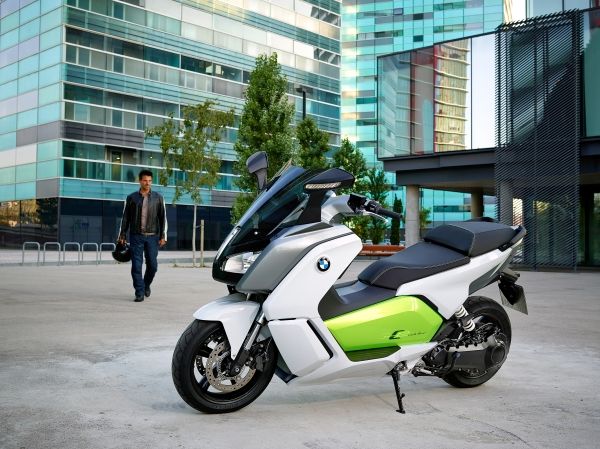Much of the hype around BMW with low carbon transportation right now is the to market plans of its i8 plug-in hybrid and i3 electric car, but the automaker is also making steps in greening other parts of its mobility inventory as well. One area in which this is happening is scooters, with news that its new C evolution electric scooter will debut in Europe next year.
BMW has been showcasing the C evolution as a concept since mid-last year, and it is nice to see it is actually heading into production, even if it is only a European release for now. This new scooter, while developed under the BMW Motorrad label, does have in common with the eco-focused i brand a “visionary vehicle concept offering maximum everyday practicality and an inspirational design,” as BMW puts it.

image via BMW
The C evolution is powered by a drivetrain swing arm with liquid-cooled permanent magnet synchronous motor via a toothed belt and ring gearing. Its rated power output is 11 kW (15 hp), with a peak output of 35 kW (47 hp), allowing for it to hit a top speed of 120 km/h (75 mph, electronically limited).
The electric motor draws its energy from an 8 kWh lithium-ion battery that
allows the two-wheeler to cover a range of up to 100 kilometres (62 miles) before it needs to be charged from any domestic mains supply. When plugged in to a standard 220V domestic socket with a 12A charge current, recharging fully from empty takes around 4 hours (with 220V / 16A = 3 h).
Energy regeneration to the battery, besides plugging it in to an electric vehicle charger, can happen in a fashion similar to that of other green vehicles. For the C evolution, this process takes place automatically both when coasting with the throttle closed and when braking. To help in this recharging, the scooter comes with four ride modes which allow for a range of mix choices between dynamic performance and efficiency.
In a nod to shared technology, the scooter has the same energy storage modules and electronic componentry used in the BMW i3. Other features include limiting of the motor’s torque depending on the slip at the rear wheel, an LED daytime running light and a large TFT color display. From this latter item one can keep up with a host of data such “as the average consumption in kWh/100 km, total power consumption, battery charge status in kWh, average speed, voltage of the on-board electrical system and the high-voltage system, as well as the remaining range in kilometres taking into account the selected ride mode.”
There was no immediate word of pricing.






